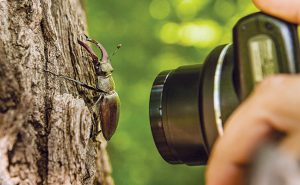The July Mobile PMP column examined several factors that can improve the likelihood of making a digital identification of an insect or other arthropod. This has led me to look at my own data from 2016, to see how many digital IDs I was asked to make during the course of that year.
My total was 136. This figure does not include actual specimens sent to me, which I estimated were approximately 32. I do not have accurate records of these, however, because I did not accurately count specimens I looked at in offices across North America.
To organize my digital IDs, I made five distinct categories:
- Images I couldn’t ID with the provided information and digital image.
- Specimens that, although I had good images and existing field notes, were too similar to another species to ID with accuracy. Therefore, no ID.
- Images for which I could make only a partial ID. For example, it’s a Dipteran (fly), Coleopteran (beetle), etc.
- Images I could easily ID and distinguish the specimen because of its commonality and quality of the photo.
- Images I could ID with difficulty. In other words, I successfully enhanced with photographic software first. In some cases, I had a good series of images, but required research in insect keys to decipher the specimen’s taxonomy.
As you can see, if your digital IDs fall into categories 1 and 2, which in my case accounted for 35 percent of all requests I received in 2016, then you need a specimen in hand to ID.
Category 3 can have variables, because some partial IDs may suffice for the pest situation (it’s a grasshopper in a restaurant) or be dangerous to make (it’s a “small fly” in a restaurant). Obviously, a careful decision should be made toward accuracy of the ID depending on the situation. This is where additional information is critical to the ID.
When making digital IDs on pests that are common and easily described, such as those counted in category 4, it’s important to remember that poor-quality digital photos accounted for at least 25 percent of the specimens I received in 2016. This pushed what could have been a definitive ID into “I know what order it belongs to — it’s a beetle, a fly, a millipede — but I cannot drill down any further with confidence.”
A basic understanding of the pest group is helpful, but it may not be enough to assist in providing pest management advice. This is where knowing additional collection data may be helpful in separating what species is actually involved. Ask follow-up questions about what time of day it was found, where it was found, and what conducive conditions (moisture, heat, food) were nearby.
In September’s Mobile PMP column, I’ll discuss available technology and how it can help us in our struggles to ID field specimens. In the meantime, happy bug hunting!
| Category | Description | Actual Number of ID Requests | % of Requests (RN) |
|---|---|---|---|
| 1 | Couldn’t ID | 30 | 22% |
| 2 | Too similar to other species, no ID | 18 | 13% |
| 3 | Partial ID | 34 | 25% |
| 4 | Could easily ID | 49 | 36% |
| 5 | ID made with difficulty | 5 | 4% |
| Total | 136 | 100% |
Digital ID best practices
- Don’t be too hasty to help clients by making a guess at digital images. This helps neither the client nor
your company. - Set up for your clients all the collection data needed and parameters for submitting images for ID. You may not get 100 percent compliance, but the numbers can be better all-around if you let clients know your expectations so you can help them the best you can.
- Get help when you know you need it. I’m fortunate to have an excellent team of entomologists with experience in the field. Hire an experienced entomologist if you need help.
White is technical director, Rentokil Steritech. You can reach him at gwhite@rentokil.com.

Leave A Comment